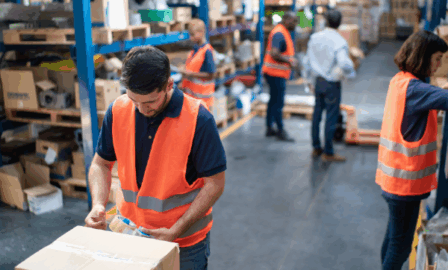2023 Gartner Supply Chain Symposium/Xpo Recap
Clarkston supply chain expert and client solutions executive Stacey Erickson recently attended the 2023 Gartner Supply Chain Symposium, where leaders and executives gathered to discuss supply chain trends, strategies, opportunities, and challenges within the industry. In this piece, she shares her brief thoughts and takeaways from this year’s event.
This year’s theme for the 2023 Gartner Supply Chain Symposium/Xpo was “Unlocking the Collective Potential of Supply Chain.” During the three-day event, supply chain leaders and executives centered discussions and panels around how to continue to navigate constant disruption, invest in people and productivity, develop agile and resilient supply chains, and prioritize technology investments to achieve objectives.
Below, we’re sharing four key takeaways from the 2023 Gartner Supply Chain Symposium/Xpo:
1. Investing in People: Human-Centric Work Design
The productivity of supply chain employees is the lowest it has been in decades, with 89% of supply chain employees reporting feeling overwhelmed according to Gartner. This is creating a need to develop more human-centric leadership, where human leaders are prioritizing and incorporating authenticity, empathy, and adaptivity into their management and leadership styles. Further, as the industry continues to also feel the effects of a labor shortage amidst ongoing disruption and uncertainty, securing and retaining top talent must be a top priority for Chief Supply Chain Officers (CSCOs).Taking a human-centric approach to work design means that CSCOs and other leaders need to prioritize their employees as people, not just employees. Individuals are demanding more in their work careers, particularly in a competitive talent market, and they’re increasingly viewing work as a subset of life (work isn’t the only important thing in their lives). Supply chain leaders must recognize this and prioritize Employee Value Proposition (EVP) to give employees more control in their work life – offering radical flexibility, personal growth, holistic well-being, shared purpose, and deeper connections.
“Imagine what is possible when the question isn’t how quickly can they learn my supply chain, but rather how quickly can they change my supply chain.” Caroline Chumakov (Director Analyst, Gartner) speaking to supply chain talent
2. Potential to Accelerate Digitalization
Growth remains a top priority for CSCOs, and they see advancing their digital maturity as the way to progress and achieve that necessary growth; however, that digital journey can be a costly one and no one wants to go into an investment with hesitation or doubt, particularly with 67% of Chief Financial Officers saying that digital is underperforming across their organizations. As such, leaders need to approach digitalization with these things in mind: Align, Focus, and Scale.
Align: Often, each function will have its own digital projects. It’s best to create an integrated roadmap aligning the digitalization efforts. You also should consider developing a Digital Steering Committee.
Focus: In order to scale digital adoption, you’ll want to focus on efforts that are aligned to strategy. This includes gapping current processes to future and determining which ones have the most opportunity for digitization. Leaders will need to prioritize the path to take and select the right tools along the way.
Scale: Realizing value requires scale. Historically, organizations have been overly optimistic about the adoption of a solution across an entire enterprise. Moving forward, supply chain leaders need to consider their solution’s scalability and adaptability as their organization evolves and grows, too.
3. Balance the Person and the Machine
Technology has immense and perhaps unlimited potential to empower employees and change the way they work and operate on a daily basis. It’s important, however, to consider the human-machine relationship in this scenario in order to reduce digital friction, establish greater connectedness, remove distractions, and prevent errors. Humans must accept, understand, and utilize the technology, while the technology must also adapt to input from humans.To achieve this balance, organizations should consider new ways to partner individuals and technology, and most importantly make sure there is technology adoption. We are living in a world of fast-paced technology introduction and transition, but the adoption isn’t taking off. Why? Think about the technology and solutions your company already owns. Are people using them to their full potential? Do they know how to use them? Is the technology designed with the human interaction in mind? If your people aren’t already leveraging tools and solutions you own because they don’t know how to, why bring in new things? The answer: don’t!Leaps in investments require leaders to go first, become champions of the change, ignite their employees, and follow through from implementation through adoption. Change management initiatives are critical here, and leveraging KPIs and metrics to govern utilization and measure adoption can’t be overlooked.
4. Sustainability Across the Supply Chain
We’re seeing sustainability as a huge trend across all industries, and the supply chain is no different. Achieving true sustainability in your supply chain requires deep multi-tiered supplier collaboration – supplier partnerships must coordinate changes across the entire supply chain and turn their internal efforts into external-facing ones. CSCOs and leaders must assess if their sustainability goals are feasible and attainable based on their current supply base and supply chain constraints. We’re seeing leaders struggle with having goals and objectives in place, but the execution is lacking, perhaps due to suppliers who aren’t equally invested nor have the resources or ability to hit those sustainability targets.The solution lies in spreading sustainability knowledge across the organization and across suppliers. The more educated your organization is, the better chance you have at achieving your goals. It also lies in data. Being able to measure your progress, embed sustainability into your goals and communications, and track your actions and metrics. As stakeholders increasingly demand more when it comes to social and environmental sustainability, taking a bare-minimum approach isn’t an option. Comprehensive roadmaps and programs should already be established; if they aren’t, then you risk falling behind.
Looking Ahead
Taking lessons learned from the past three and a half years, many are looking to embrace opportunities to improve capabilities and enhance resiliency, with 79% of CSCOs said they’re going to be more proactive and better prepared in the months to come (Gartner). As we move into the second half of 2023 and beyond, I’m thinking back to something that Joanne Joliet, VP Analyst at Gartner said at the Symposium: “Anticipate risk. Secure talent. Accelerate digital.”
If you’d like to chat more about key topics and trends from the 2023 Gartner Supply Chain Symposium/Xpo or are looking for strategic guidance for your supply chain operations, connect with one of our experts today.



